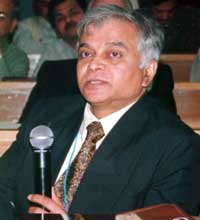 Dr. Anil Karapurkar
Dr. Anil Karapurkar
Dr Anil Karapurkar completed his training in Neurosurgery from KEM Hospital, Seth GS Medical College, Mumbai in 1975. He subsequently worked as Tutor, Asst. Prof., Assoc. Prof and Prof. in Neurosurgery at the above institutions.
He took voluntary retirement and joined Indraprastha Apollo Hospital, New Delhi where he worked from 1996 to 2002. In 2002 he returned to Mumbai and has been working in various hospitals. At KEM he started performing transfemoral angiography along with his colleagues Dr Sunil Pandya and Dr R D Nagpal in 1976. From 1978 embolisation for tumors and brain AVM was performed by Prof Pandya and Anil Karapurkar.
In 1980-81 Karapurkar received training in endovascular procedures under Prof Luc Picard, the doyen of Neurointervention, in Nancy, France. Subsequently he received further fellowships from Govt of France for training under Prof Picard and Prof Jacques Moret of Fondation Opthalmique de Rothschilde, Paris, France. He has been the past president of AAFITN ( Asian & Australasian Federation Of Interventional Neuroradiology). He has been on the Advisory Board of WFITN. ( World Federation Of Interventional Neuroradiology). Since 2002 he has completely given up Neurosurgery and devoted himself to this new medical speciality of Neuro Vascular Interventions. He has trained several Neurologists, Neurosurgeons and Radiologists in this exciting speciality.
In 2019 DNB has started a new post-doctorate fellowship program,
FNB in Neuro Vascular Interventions. This is a full time 2 year structured program with entrance and exit exam. Neurologists with DM or DNB (Neurology), Neurosurgeons with MCh or DNB Neurosurgery and Radiologists with M.D., DNB in Radiology or DM Neuroradiology are eligible to appear for the entrance exam. The first batch of 2 Neurosurgeons has commenced training at the Breach Candy Hospital, Mumbai under Prof Karapurkar and DR Rakesh Singh.
Prof. Karapurkar over the years has treated thousands of patients with neurovascular diseases such as acute arterial ischemic stroke, aneurysms, brain arterio-venous malformations and fistulas, (AVM and AVF), neoplasms such as meningiomas, glomus tumours and paragangliomas, prevent stroke with angioplasty and stenting of carotid and vertebral arteries in the neck and intracranial arteries, acute venous stroke with thrombolysis, spinal cord AVMs and AVFs, spinal neoplasms, vertebroplasty for compression fractures and neoplasms etc.
The treatment of acute ischemic stroke has been revolutionised since 2015. Thrombectomy where the offending clot is extracted using either a special non detachable stent (Stent-triever) or large bore suction catheter. The artery is recanlised within 15 minutes and clinical improvement or cure is noted in more than 70% of patients. Results in posterior circulation and dominant artery occlusion is particularly gratifying.
If required balloon angioplasty and stenting have been done in the acute setting. Aneurysms have been treated with simple coiling, coiling with the help of single or double balloons, stent assisted coiling with single and double stents. Flow diverters for giant and fusifom inoperable aneurysms are the new tools in the armamentarium. Flow diverters with or without additional coils have been used in the treatment of giant, fusiform and dissecting aneurysms with preservation of the parent vessel. Giant aneurysms are being treated less and less by occlusion of the parent artery even if the patient has passed the balloon occlusion test. Web device has been used in the treatment of bifurcation aneurysms. Peripheral intracranial and spinal aneurysms have been treated with injection of glue.
Brain AVMs have been treated by embolization. Embolization was earlier done with Histoacryl, a glue which hardens rapidly when it comes in contact with blood. For the last 14 years most AVMs have been treated by Onyx alone and the cure rate with embolization alone has gone upto about 50% for large AVMs and 100% for small AVMs. Residual AVM is treated by surgical excision or SRS ( stereo-taxic- radiosurgery). Dural and pial AVF need careful planning. The cure rate for dural AVF has been 100% with virtually no complications. Embolisation is done by occluding the venous side by injecting Onyx through the arterial route. Rarely coils /and glue are used. Spinal cord AVM is treated with glue ( Histoacryl).
Stenting for focal stenosis of the extracranial and intracranial arteries has been done with low rate of complications. Extracranial stenosis is stented under local anesthesia and intracranial under General Anesthesia. Self-expanding carotid stents are used for extracranial stenosis and balloon mounted coronary drug coated stents are used for intracranial and distal stenosis. For venous sinus thrombosis thrombo-lysis has been done by cannulating the occluded sinsus and injecting urokinase or etracting the thrombus with a stent-riever.
For intra-, juxta-cranial and spinal neoplasms, embolization is done to facilitate surgery and reduce blood loss. It is done with particles injected through a microcatheter or by filling the tumour bed with glue ( Histoacryl).
For spinal fractures and neoplasms vertebroplasty with bone cement is done.

